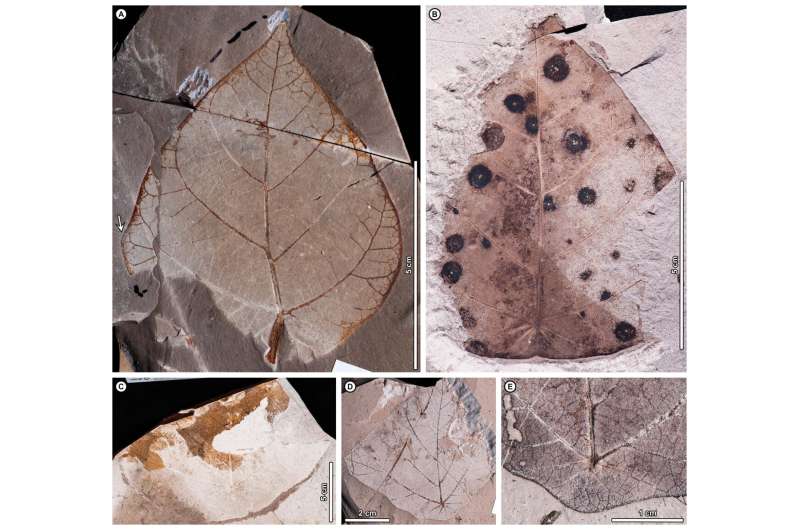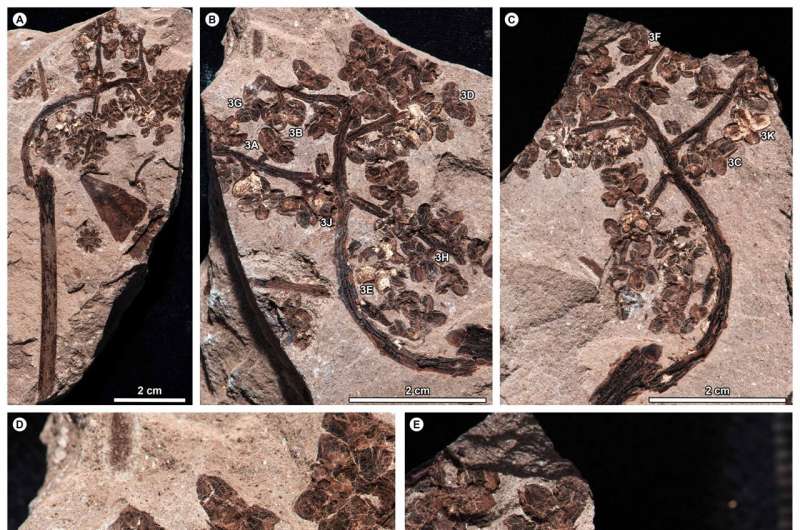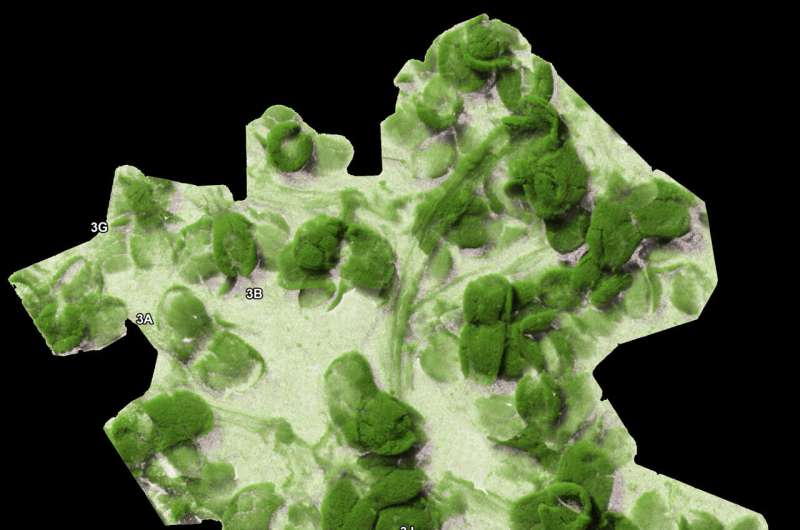Anyone who has taken a long road trip or bike ride has used a product of the spurge plant family—rubber. The spurge family, or Euphorbiaceae, includes economically valuable plants like the rubber tree, castor oil plant, poinsettia and cassava. Newly identified fossils found in Argentina suggest that a group of spurges took a trip of their own tens of millions of years ago.
Driven by climatic changes ands land movements over millennia, a group of spurges relocated thousands of miles from ancient South America to Australia, Asia and parts of Africa, according to research led by Penn State.
Reported in the American Journal of Botany, the findings suggest that the spurge family’s Macaranga-Mallotus clade (MMC), encompassing a common ancestor and all its descendants and long considered to have Asian origins, may have first appeared in South America when it was still part of Gondwana—the supercontinent that encompassed South America, Antarctica and Australia—before spreading around the globe.
“Our study provides the first direct fossil evidence of spurges in Gondwanan South America,” said Peter Wilf, professor of geosciences at Penn State and lead author of the current study, noting that the finding contrasts with the prevailing idea that the MMC evolved in Asia.
“But if they evolved in Asia, how in the world would they have gotten to where we found them, in Argentine rocks 50 million years old? Instead, we think these spurges tracked the moving continents from South America to Asia, to the other side of the world. You can’t go much farther than that without leaving the planet. We’ve seen this pattern in many other plant groups we’ve found as fossils in South America like kauris, Asian chinkapin and yellowwood trees. Altogether it is the most dramatic evolutionary biogeography story I’ve ever seen.”

According to Wilf, Euphorbiaceae have adapted well to evolutionary challenges in different environments.
“They’re common in tropical rainforests in Africa, South America and most notably in Asia, where if you count the number of trees in a plot, they’re usually the second most common type,” he said.
“They make up much of the understory habitat that is structurally important to the rainforest and its animal life. The MMC is well known in the Asian tropics and is highly visible along roadsides and in burned areas. Its plants often have large, umbrella-like leaves that provide abundant shade, and they provide nutritious seeds for animal forage.”
The spurge family comprises more than 6,000 species, found mostly in the tropics but also in deserts and cold temperate zones, and there are about 400 species in the MMC alone. Given their prevalence in southeast Asia and 23-million-year-old fossils previously found in New Zealand, scientists have considered the MMC an “Old World” plant group likely with Asian origins.
The current study, based on fossils more than twice as old as the New Zealand specimens, provides the first evidence of “New World” origins for MMC spurges and adds two new species to the plant family, according to the scientists.

Wilf and his colleagues at Argentina’s Consejo Nacional de Investigaciones Científicas y Tecnológicas (CONICET) in Bariloche and the Museo Paleontológico Egidio Feruglio (MEF), and Cornell University examined 11 leaf fossils and two compound infructescence fossils, or fossils that show preserved fruits and seeds attached to branches.
The fossils came from a site in Chubut, Argentina called Laguna del Hunco, where the researchers have collected fossils for decades. Dating of volcanic rocks at this site places the fossils at 52 million years old, a globally warm time immediately preceding the final separation of Gondwana.
The scientists studied the detailed characteristics of the leaves and fruits and compared them with living specimens. They also took CT scans of the infructescences at the Penn State Center for Quantitative Imaging. The scans picked up density changes in the rock and rendered them into three-dimensional images that the researchers used to study the fruits’ features, including tiny paired seeds inside the fruits that were barely visible at the surface.
The researchers found that the characteristics of the fossil fruits and leaves are only found today in MMC spurges, identifying them as two new species. They named the infructescences after the late Rodolfo Magín Casamiquela, an Argentine vertebrate paleontologist and anthropologist who collected one of the specimens, perhaps as early as the 1950s, and the leaf species after Kirk Johnson, paleobotanist and Sant Director of the Smithsonian National Museum of Natural History who had discovered the first of the leaf fossils in the 1990s.
“The MMC is widely distributed, but prior to this research they’ve never been found growing naturally in the Americas,” Wilf said. “This is the first time that the MMC has been reliably documented anywhere in the Western Hemisphere past or present.”

The fossils tell a story about environmental changes, plate tectonics and biogeography, or the distribution of plants and animals around the world, Wilf said. The plants likely originated and evolved in Gondwana and began retreating as the climate grew drier and colder over millions of years, suffering extinction in Antarctica and South America but apparently surviving in Australia, he said.
At the same time, plate tectonics were pulling apart the Gondwanan supercontinent. Australia broke away from Antarctica more than 40 million years ago and collided with southeast Asia 25 million years ago, bringing the water-demanding plants to New Guinea and the southeast Asian rainforest, the researchers said.
“We’ve seen over and over again that we can trace a significant number of Australian and Asian rainforest plants all the way to Argentina and Western Gondwana,” Wilf said.
“These fossils tell us how plants respond to environmental changes. If you give them time and an escape route, like Australia as it moved from the Antarctic latitudes to Asia, they can move around the world following their preferred environment and thrive. Deforestation and environmental changes today, including in southeast Asia where our Gondwanan survivor trees live, are occurring 100 to 1,000 times faster than they did millions of years ago, and escape routes have been converted into cities and agriculture.”
“These fossils serve as a warning from the deep past, that the natural world that we rely on is extremely resilient but cannot keep up with us. It is not too late to act and avoid the worst outcomes.”
More information:
Peter Wilf et al, The first Gondwanan Euphorbiaceae fossils reset the biogeographic history of the Macaranga‐Mallotus clade, American Journal of Botany (2023). DOI: 10.1002/ajb2.16169
Provided by
Pennsylvania State University
Citation:
Spurge purge: Plant fossils reveal ancient South America-to-Asia ‘escape route’ (2023, July 25)
retrieved 26 July 2023
from https://phys.org/news/2023-07-spurge-purge-fossils-reveal-ancient.html
This document is subject to copyright. Apart from any fair dealing for the purpose of private study or research, no
part may be reproduced without the written permission. The content is provided for information purposes only.

